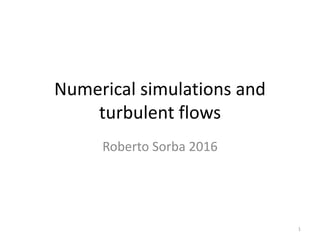
Turbulence numerical modelling
- 1. Numerical simulations and turbulent flows Roberto Sorba 2016 1
- 2. The challenge of turbulence modelling • We define the rate of kinetic energy dissipation (from large eddies to small ones) as ε (dimensionally energy / time). • The Kolmogorov scale for the smallest eddies is • Assuming a typical Reynold value of 200.000 and that the turbulent fluctuation u’ is 5% of the mainstream velocity U we get the turbulent Reynolds number: 2
- 3. • In order to include even the smallest eddies in the simulation the required number of grid nodes for just one dimension is • In a 3D simulation thus we need a mesh with at least 1 billion nodes per iteration • Three main possible approaches: – DNS: Direct solving of the Navier-Stokes equations – RANS: time-averaging of the NS to reduce computational load – LES: direct solving of bigger-scale eddies and modelling of smaller ones 3
- 4. Direct Numerical Simulation • Actual computational solving of the Navier-Stokes equations, performing over (at least) 1 billion node calculation per passage • No turbulence-related simplifications are included • Easily takes 2-3 months to simulate a few seconds, not competitive in today’s industry 4
- 5. The maths behind DNS: • space discretization with finite-difference method • time discretization with explicit method The Navier-Stokes equations: mass and momentum conservation, without any simplification 5
- 7. • This method relies on Taylor’s series theory to provide an approximation for the first and second derivatives: • For every node we can re-write the NS equations by substituting this in the place of the first and second order derivatives; this substitution does not apply to the boundary nodes, where boundary conditions apply instead (which obviously are different for each problem) • The solver code creates a sparse matrix with the coefficient of these newly-written equation and can solve the (now algebric) system 7
- 8. Time discretization • An explicit solver method for an ODE (ordinary differential equation) can be generically written in such form: • K = time index • h = time step • Φ = function representing the first derivative • The are called “explicit” because they use only the present time value and the present function value to compute the next function step; by doing this they take longer to converge to solution but allow us to cut down on computational power 8
- 9. • Disadvantage: explicit methods may be unstable (not converging), amplifying the numerical error after each step instead of reducing it. • In order to ensure numerical stability we have to stick to the Courant-Friedrichs-Levy condition (CFL condition): • The left-hand term in known as the Courant number; since h is already very small, the time intervall will have to be consequently small as well. 9
- 10. • When a flow moves through a discretized grid, the time interval must be smaller than the time needed by the fluid particle to pass through two adjacent element in this grid. • This ensures that information is correctly propagated and errors are not amplified; however, it can become a strict limits in the eventuality of high Reynold number 10
- 11. RANS •Differently from DNS, RANS are already time-averaged, so they provide a time-independent overview of the problem •RANS are better solved with the finite-volume method 11
- 12. Finite Volume Method • It is based on the Reynold transportation theorem: the overall change in a generic property (B) can be written as the sum of a volume integral and a surface integral. • If the property is conserved, the rate of change is null and it holds: 12
- 13. • This equation is finally discretized to obtain the changes in the control volume • Numerical calculation of the flux at the boundary of a cell (right-hand side integral, the flux is the argument of the integral): • Usually cells have more than 4 borders, in commercial software they are hexagonal 13
- 14. • Calculation of the boundary integral: • Notice that this is actually the sum of four integral, one per border; we can then write the algebric equation • The value of B is then spread to the nodes with a propagation method; implicit method are quicker and intrinsecally stable, but more computationally expensive 14
- 15. Large Eddies Simulation • The grid required by DNS easily exceeds the computer capacity • A coarser grid is used, which can only appreciate the larger scale eddies; information about eddies whose scale is smaller than the grid is removed • Smalle eddies cannot be simply neglected; their influence has to be accounted for with a subscale theoretical model • Filtering of the Navier-Stokes equations: • RANS used a time-averaging filter that caused to be ; LES uses a spacial filter that reduces the amplitude of the scales of motion • LES is particularly suited for complex flow with large scale structures 15
- 16. 16
- 17. • We can also combine different methods within the same simulation session (example of a turbine blade) 17
- 18. Comparison DNS RANS LES Simplifications none Time-averaging Hypothetical small- scale modelling Common numerical process Finite difference, explicit methods Finite volume method Finite volume, implicit methods Effort Maximum Low Depends on task Accuracy High Low Medium Usage field Academical research Vehicle preliminay study, feasibility study Instability effects, further development studies Limitations High time requirement, not competitive Low accuracy, cannot model instability Usually requires finer mesh than RANS 18
- 19. Sources • Maries, A., Haque, M. A., Yilmaz, S. L., Nik, M. B., Marai, G.E., New Developments in the Visualization and Processing of Tensor Fields, Springer, pp. 137-156, D. Laidlaw, A. Villanova • Fröhlich J., Rodi W., Introduction to Large Eddy Simulation of Turbulent Flows, Lectures at the University of Karlsruhe, 2002 • Denton J., The evolution of turbomachinery design (methods), PCA 2009 19